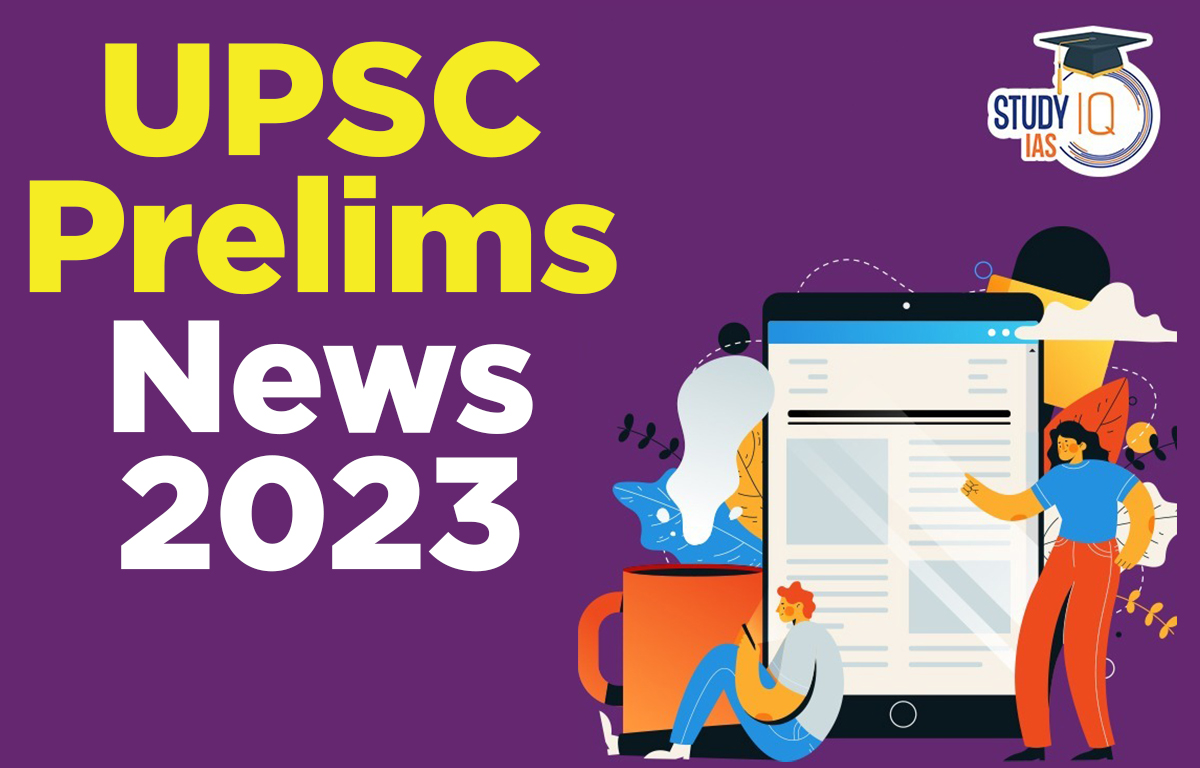UPSC Prelims News of 12 January 2023
Blackbuck
Context: A new IISc study highlights how blackbucks have faced natural and human-induced challenges for their survival.
- Blackbuck (Indian Antelope) is a species of antelope native to India and Nepal.
- They inhabit grassy plains and thin forest areas.
- Habitat: In India, they can be found in three clusters spanning across the states of Rajasthan, Gujarat, Madhya Pradesh, Tamil Nadu, Odisha, and other areas of peninsular India.
- Features: Males have corkscrew-shaped horns and black-to-dark brown coats, and females are fawn-coloured.
- Threats faced:
- Dense human habitation makes it difficult for them to migrate from one cluster to another.
- Illegal hunting
- Decrease in habitat due to expansion of agriculture
- Protection Status:
- Wildlife Protection Act 1972: Schedule I
- IUCN Status: Least Concerned
- CITES: Appendix III
- Protected areas:
- Gir National Park, Gujarat
- Kanha National Park, Madhya Pradesh
- Ranthambore National Park and Tal Chhapar Sanctuary, Rajasthan
- Ranebennur Blackbuck Sanctuary, Karnataka
- Vallanadu Wildlife Sanctuary, Tamil Nadu
- Kaimur Wildlife Sanctuary, Bihar
UPSC Prelims News 11 January 2023
Virtual Power Plants
Context: Companies like Ford, Google and Solar Energy producers are working together to establish standards for scaling up the use of Virtual Power Plants(VPPs).
- A Virtual Power Plant (VPP) is a network of decentralised, medium-scale power generating units as well as flexible power consumers and storage systems.
- The objective of a virtual power plant is to connect different energy sources into one cohesive unit. These can be anything from solar and wind farms to energy assets and battery storage units.
- In a traditional power plant, Energy generation occurs in one fixed location. When energy demand increases, more fossil fuels are burnt.
- While in VPPs, rather than having one single place of operation, VPPs draw their energy from multiple locations in order to maintain grid stability.
Lal Bahadur Shastri
Context: The death anniversary of Lal Bahadur Shastri was commemorated recently.
- Lal Bahadur Shastri was born on 2nd October 1904 and was the second Prime Minister of India, who served from 1964 to 1966.
- His participation before India’s Independence include:
- In the 1920s, Shastriji became an active member of the Indian Independence Movement, in which he joined the non-cooperation movement.
- He was sent to jail by the British for his participation in the Salt Satyagraha (1930), and Quit India Movement (1942).
- Later, he took office as India’s prime minister in 1964, and his achievements include:
- He advocated for the White Revolution, and assisted the Amul milk cooperative in Gujarat and founded the National Dairy Development Board.
- He supported the Green Revolution, which increased food grain productivity in states like Haryana, Punjab, and Uttar Pradesh.
- He also gave the slogan “Jai Jawan Jai Kisaan”.
- He signed the Tashkent Declaration in 1966 with Pakistan’s President, to end the 1965 war.
- He died in 1966 and was awarded the Bharat Ratna in 1966, by the Government making him the first posthumous laureate of this prestigious award.
Paigah Tombs and Paigas
Context: US Ambassadors Fund for Cultural Preservation will be providing a grant for the restoration of Paigah Tombs Complex of Hyderabad.
- The complex consists of 27 marble tombs with intricately carved walls and pillars, delicately patterned filigree screens and turrets.
- Origin: The origin of Paigah Tombs can be dated to the late 18th century.
- Artistic features: The tombs are known for their inlaid mosaic tile and the famous ‘jaali’ work.
- Architecture: They are considered a fine example of Indo-Saracenic architecture.
- It is a mixture of Asaf Jahi and the Rajputana styles of architecture. The influence of Mughal, Persian and Deccani style is visible.
- Paigahs:
- Paigahs were essentially the highest-ranking noble family in the state of Hyderabad who married the daughters of the Nizams.
- They were the only ones who were allowed to have a private army by the Sultans.
- Members of the Paigah family were loyalists of the Nizam and served as statespeople, philanthropists and generals.
Tashkent Declaration
Why in News? The Tashkent Declaration was a significant milestone in the history of India and Pakistan.
About:
- The Tashkent Declaration was a historic document signed on 1966, by the Indian Prime Minister Lal Bahadur Shastri and Pakistani President Ayub Khan.
- It was a peace agreement to resolve the Indo-Pakistan war of 1965.
- It was signed at Tashkent, capital of Uzbekistan which in turn was a part of one of the republics that comprised of the USSR.
- The main aim was to restore economic and diplomatic relationships in the respective countries and to work towards the progress of bilateral relations.
Citizenship Act 1955
Why in News? Constitution Bench to take up Section 6A of Citizenship Act for preliminary determination.
About:
- The Citizenship Act, 1955 provides for the acquisition and determination of Indian citizenship.
- The Act does not provide for dual citizenship or dual nationality.
- It only allows citizenship for a person listed under the provisions above i.e., by birth, descent, registration, or naturalisation.
- The Citizenship Act, 1955 was amended 6 times in 1986, 1992, 2003, 2005, 2015 and 2019.
- The purpose of the Citizenship Amendment Act, 2019 is to give Indian citizenship to illegal migrants of 6 communities (i.e., Hindu, Sikh, Buddhist, Christian, Parsi, and Jain) belong to Bangladesh, Pakistan, and Afghanistan.
- Through these amendments Parliament has narrowed down the wider and universal principles of citizenship.
National Clean Air Program
Why in News? Only 49 of 131 cities that were given pollution reduction targets have recorded an improvement in air quality.
About:
- It was launched by the Ministry of Environment, Forests and Climate Change (MoEFCC) in January 2019.
- It is the first-ever effort in the country to frame a national framework for air quality management with a time-bound reduction target.
- It seeks to cut the concentration of coarse (PM10) and fine particles (PM2.5) by at least 20% in the next five years, with 2017 as the base year for comparison.
- It covers 132 non-attainment cities which were identified by the Central Pollution Control Board (CPCB).
Bhopal Gas Tragedy
Why in News? Recently, The Union Carbide Corporation (UCC) said that it is unwilling to pay “farthing” more.
About:
- On December 3, 1984, Methyl Isocyanate (MIC) gas leaked from a plant operated by Union Carbide India Limited (UCIL) at Bhopal (Madhya Pradesh).
- The gas drifted over the densely populated neighbourhoods around the plant, killing thousands of people immediately and creating a panic as tens of thousands of others attempted to flee Bhopal.
- After the tragedy, the government of India enacted a Public Liability Insurance Act (1991), making it mandatory for industries to get insurance the premium for this insurance would contribute to an Environment Relief Fund to provide compensation to victims of a Bhopal-like disaster.
- Methyl isocyanate is a colourless highly flammable liquid that evaporates quickly when exposed to the air. It has a sharp, strong odour.
Tribal Autonomous Council
Why in News? A forum of ethnic communities excluding the Dimasa has iterated its demand for carving a separate autonomous district.
About:
- Autonomous district councils have powers to form courts to hear cases where both parties are members of Scheduled Tribes, and the maximum sentence is less than 5 years in prison.
- Autonomous district councils have powers to levy taxes, fees and tolls.
- Presently, 10 Autonomous Councils in Assam, Meghalaya, Mizoram and Tripura are formed by virtue of the Sixth Schedule.
- The Sixth Schedule of the Constitution of India allows for the formation of autonomous administrative divisions which have been given autonomy within their respective states.
USB Type C
Why in News? Recently, The Bureau of Indian Standards (BIS) has published standards for USB Type C receptacles, plugs and cables.
About:
- USB Type C cables allow high-speed data transfers and a higher power flow, allowing your phone to charge more quickly.
- USB Type C cables are also reversible and can be plugged in either way round.
- USB Type C is a 24-pin USB connector system with a rotationally symmetrical connector.
- The USB Type C port has the ability to handle higher power.
- USB Type C is designed to handle up to 100 W of power output, making it more ubiquitous for the entire device ecosystem, including heavier products such as laptops.


 UPSC Prelims News 20 March 2023
UPSC Prelims News 20 March 2023
 UPSC Prelims News 17 March 2023
UPSC Prelims News 17 March 2023





















